On the trip back from Churchill, we stopped in Winnipeg for a day. We got a hotel on the west side of town and crashed out. This was the first shower we had since before we got on the train up to Churchill.
The next morning, we checked out the Winnipeg Grist Mill. Pretty cool place, but it’s basically a replica. The waterwheel doesn’t really work, and it is powered by an electric motor now. They can grind grain, but don’t sell it. Glenn thought it was a missed marketing opportunity to sell hipster flour.
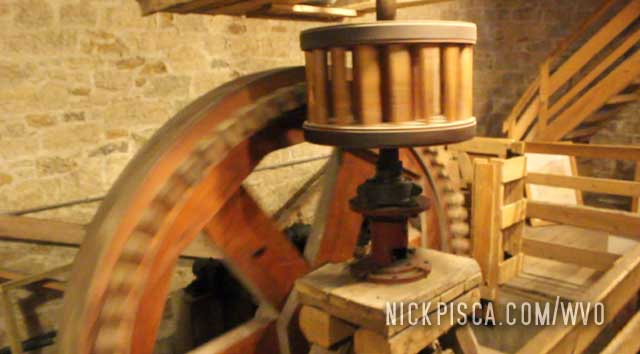
Then we scooted over to the Royal Canadian Air Museum. This has been a place that we’ve been trying to go to for years, but things never really worked out in our favor. Since we had a whole day to kill, we could take our time and check out some great Canadian aircrafts and tours. The highlight of the tour was seeing a real life AvroCar, which if you don’t know, it’s a flying saucer shaped aircraft. It actually flew too, but not much.
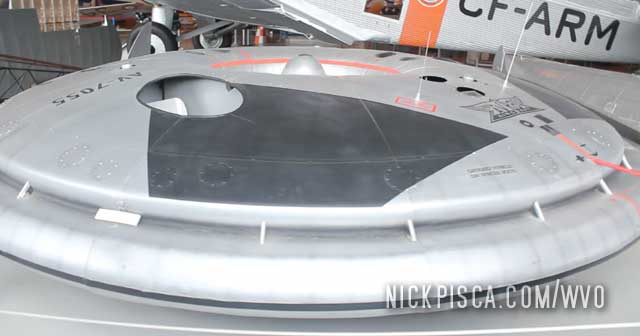
Lastly, we toured the Reil House in Winnipeg. Canada is kind of funny. Basically anything older than 75 years is considered “historical,” and the Reil family had a lot to do with the settling of Winnipeg in the early 1900’s. We toured their house, and they had a bunch of college students dressed up in character. We love jibber jabbering with these people, cuz it’s just fun. Once on a tour of Lower Fort Gary in the late 2000’s, we basically get asked to tagteam some “wench.” Glenn politely declined.
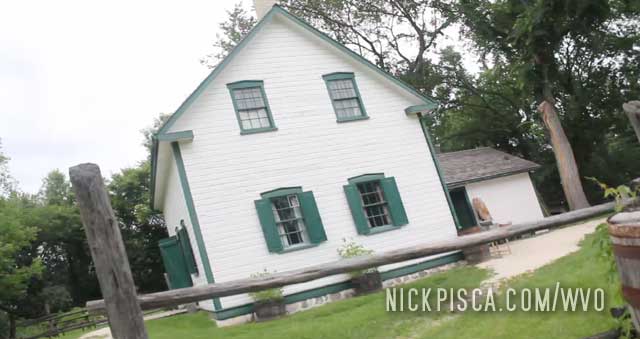
The Reil House was good. The college student who was our guide probably knew more about Canadian history than the average American college professor. The Canadians are really educated about their history and academics. Once on a trip across the Trans Canadian Highway, we listened to a CBC interview (the Canadian equivalent of NPR in the U.S.) with some educated guy. After about 30 minutes of enlightened conversation, the host of the show ended the topic by thanking the man for calling in. It turned out, that guy wasn’t being interviewed, he was just a dude who called in and sounded really educated. Pretty crazy.
The tour guide at the Reil House asked us about out politics, since the 2016 race between Trump, Hillary, and Bernie was heating up. Right around this time, the DNC was screwing Bernie Sanders, but we were on the road so much, it was hard to keep track of American topics. I told the tour guide, “Look at that van, and the Bernie Sanders sticker on the bumper. That should tell you about my politics.”
The drive down from Thompson was pretty uneventful. We took the drone out to shoot some footage of the forests, but there aren’t many mountains up here so it’s kind of all the same. Once you get down to Lundar and Ashern, it’s mostly farmland up here. There was a restaurant in Ashern that we stopped at for ice cream to cool off. It was a welcome treat to have some warmer temps after the frigid climate of Churchill and Thompson.
We pushed on to Winnipeg.
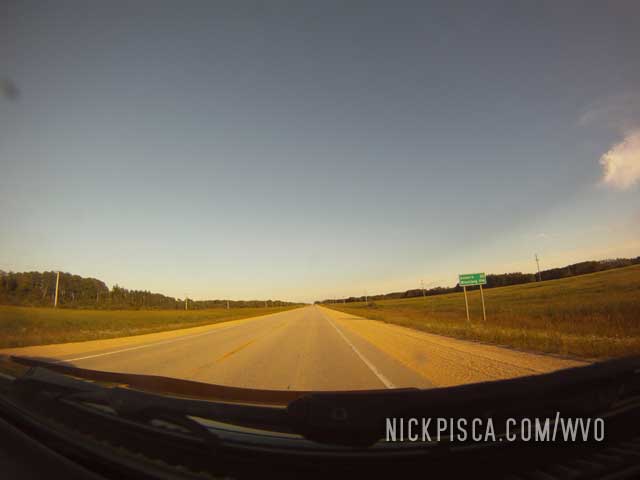
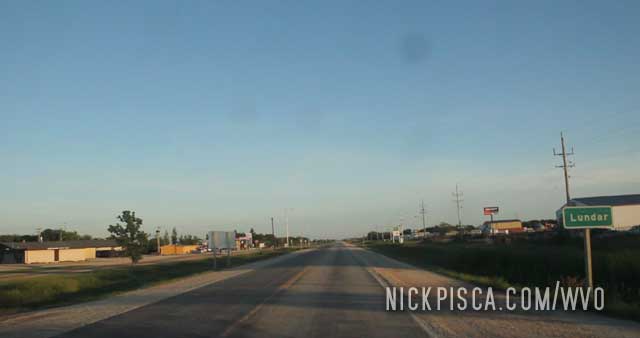
The train returned us to Thompson in the morning and our van was unmolested. We wanted to put some miles on before it gets too late, so we headed south. Several miles south of Thompson is a Thai Restaurant. It’s literally in the middle of nowhere. I saw it on the way up to Thompson, and unfortunately it was closed at that time. But now we were driving in the day, so I had to check this place out. Most of northern Canada doesn’t have any restaurants, let alone any good or exotic restaurants. So the prospect of thai food above the 55th parallel is really cool.
The food was pretty good. The ingredients weren’t that fresh, and there wasn’t much protein for vegetarians, but overall, it was better than most restaurants up there.
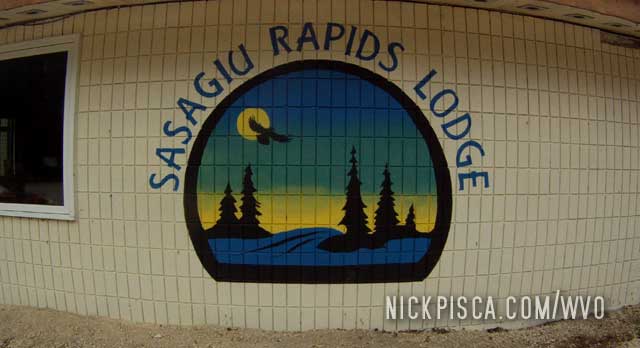
Our guide from Lazy Bear Lodge took us on a boat ride into the Hudson Bay. We got to follow a group of beluga whales and see some icebergs floating around. But the highlight of the trip was a tour of the Prince of Wales Fort National Historical Site.
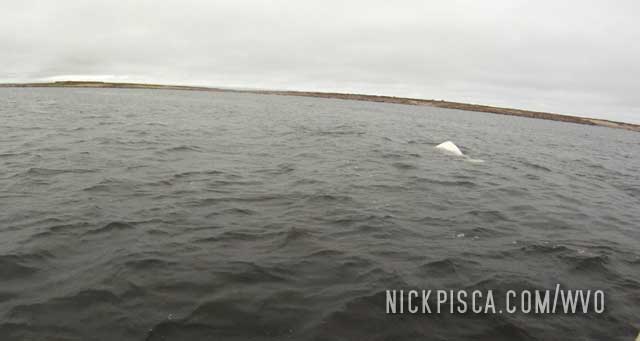
Visiting the site is very dangerous. There is always a threat of polar bears, so our guide and the National Park ranger had high powered rifles to protect the group. Created in the 1710’s, this site is really really old. This is so far back into the past, that it was constructed around the same time that Peter the Great moved the capital of Russia!
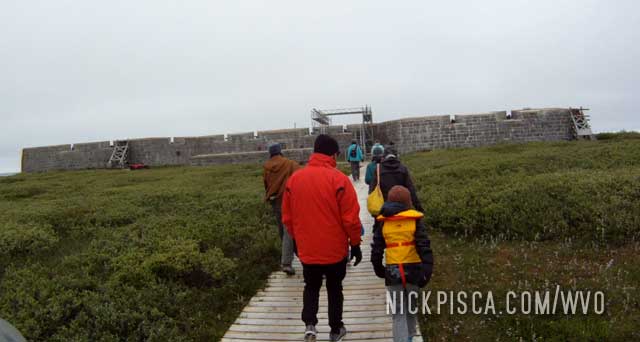
Churchill was the main destination for the 2016 WVO Roadrip. It was truly an exotic and special place.
As we approached the town, the train started to bustle with conversation and activity. Several of the occupants had been on the train for over three days, travelling the entire distance from Winnipeg. Everyone was pretty excited to get off this train. Even Glenn and I (who cheated by getting on in Thompson) who had a measly 18-hour journey was ready to depart.
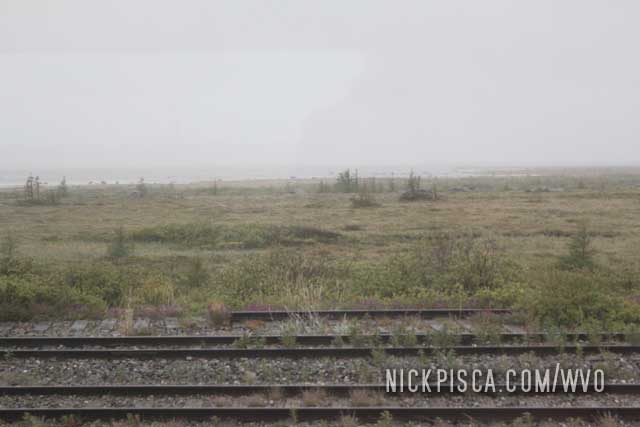
Glenn and I attempted a rather risky gamble on this trip. You see, the trains from Winnipeg to Churchill travels every 3 days. One is going northbound while the other is going southbound. That means you have to stay in Churchill for a minimum of 3 days to proceed back south. There is one workaround: take the same train back south that you took north. The train rests in Churchill for several hours before heading back south. This is a huge gamble because if the train had arrived late into Churchill, the southbound departure time DOES NOT change. So, if it was 8 hours late (not unlikely in the summer after a rain), that means the train will basically depart right after it arrived. We had already purchased our return tickets, so we were really wishing for an early or on-time arrival in Churchill. Thankfully, our arrival was nearly on time, maybe an hour late at most.
Since we didn’t know when we would have arrived in Churchill, we literally didn’t plan anything. We knew what was available to see in Churchill (Polar bear tours, beluga whale tours, Hudson Bay boating, Prince of Wales Fort Historical Site, etc) but we never booked anything because we worried that we would miss our reservation with a delayed train or mechanical failure on the van.
So we plopped off the train and asked the train station clerk for suggestions on rapid service for tours. She introduced us to the good people at Lazy Bear Lodge who got us hooked up right away.
I think time is handled a little more relaxed in this town. Since the train dictates the schedule of the town, no one is really hampered with strict reservations and whatnot. It’s pretty easy going.
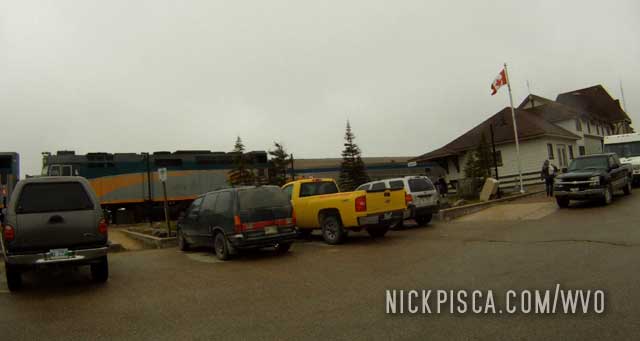
So the man from Lazy Bear Lodge took us over to his place to set up our site-seeing. He was very accommodating. He literally took us from the station to his lodge without us having any reservation or anything. On the drive, he asked us where we are staying, and we just said we are leaving on the train that evening. He was surprised, and encouraged us to stay for several days, because it’s hard to see everything in Churchill in such a short time. But he didn’t argue much (Canadian niceness) and got us on the next tour in the Hudson asap.
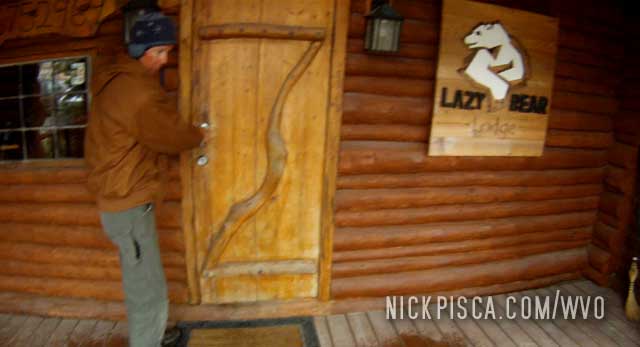
He told us the boat ride will be frigid so we needed to get our winter gear on fast. The boat left in less than hour. He also sold us some nice breakfast buffet from their lodge, so we could get some breaky before the day. If we did need a place to stay, we would have definitely stayed there. It was a nice place.
Out on the boat, he drove us passed icebergs and beluga whales. It was wild!

The boat ride took us out to the neighboring peninsula where the Prince of Wales Fort Historical Site resided. This was a blast from the past. This fort dated back to the 1710’s! Amazing this little frozen area had such old artifacts.
Our guide and the National Park ranger had high powered rifles with them. They constantly talked about the danger of polar bears. They said that if a polar bear came on the horizon, they would have to kill it for the safety of the tourists. It was serious.

After the boat ride, our guide let us venture out into the town, with the understanding that if a bear sees you, you MUST find a nearby car or house to escape into. By Churchill law, no cars or houses can be locked, so humans can find refuge. I was starting to think they residents here are overly protective or playing me. Then something proved me how serious this place is.
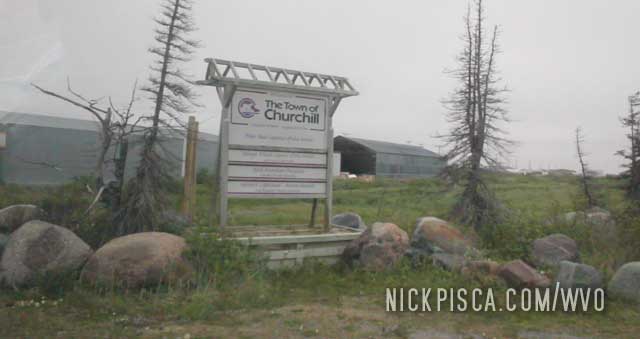
We of course wanted to visit the Hudson Bay and possibly go swimming. It was way too cold, probably in the 30’s that day and the water still had ice in it. As we walked along the shore, we saw a monument. I thought it was some kind of thing talking about the Hudson Bay. Nope. It was a literal monument to all the people who died in that bay, from boating accidents, polar bear attacks, and other things. I guess the locals were right about the risks in this area. We tossed some rocks in the water and decided to stay indoors for the remainder of the stay. No sense in risking our lives if a polar bear spotted us from the horizon.
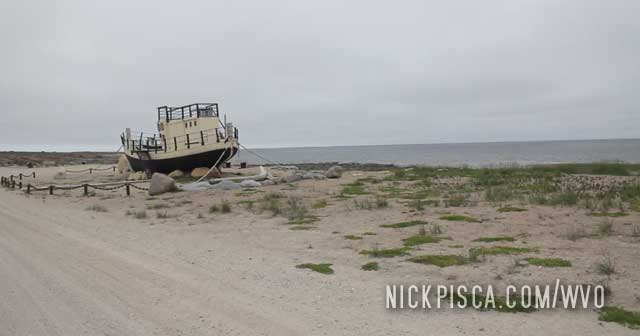
Churchill has a nice community center, as most of these northern towns have. There isn’t much to do in these places for the 22-hour darkness of the winter months, so interiority is important. Also, they have a great Eskimo / Itsanitaq Museum with dozens of artifacts and mounted animals from the north.
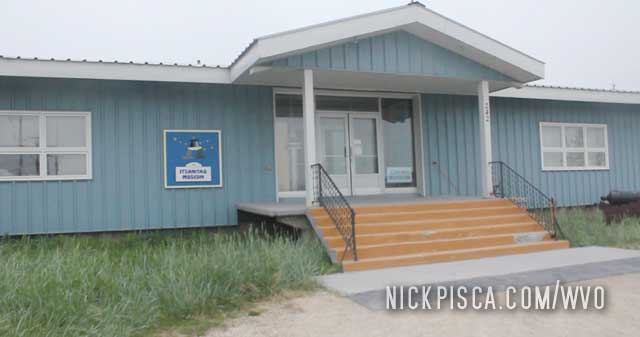
After all of that, we needed to get on the train back to the south. Even though they said we wouldn’t be able to do everything in Churchill in 8 hours, we did do a lot. We didn’t do one of the famed Polar Bear Tours, but I think we risked our lives enough for one day.
It was another 18-hour ride back to Thompson, so we elected to sleep the remainder of the train ride. It was a good day.
(Update 2017: While we were in Flin Flon on the 2017 WVO roadtrip to Fort McMurray AB, we learned from some of the locals that the train to Churchill was shut down due to railway damage. The government and corporation that handles the railway are fighting to see who will fix it. I hope they fix it soon, but if not, things will look bleak for the tourist industry in Churchill as well as for the farmers that rely on the grain transports up to the Hudson Bay for shipping across Canada and worldwide. )
The further north the train took us, the more foreign this place got. Most of this area was completely uninhabited. Miles and miles of swamps and bogs. Very few bushes and trees survived at this latitude.
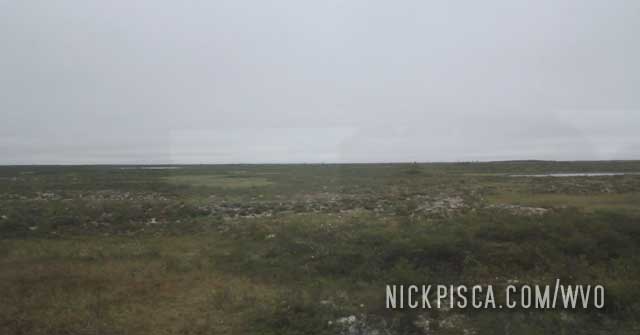
Sometimes you’d see a cropping of trees and some wildlife, but I doubt it is a pleasant place to survive. The ground is so waterlogged and spongy, it must be really hard to merely walk from place to place.
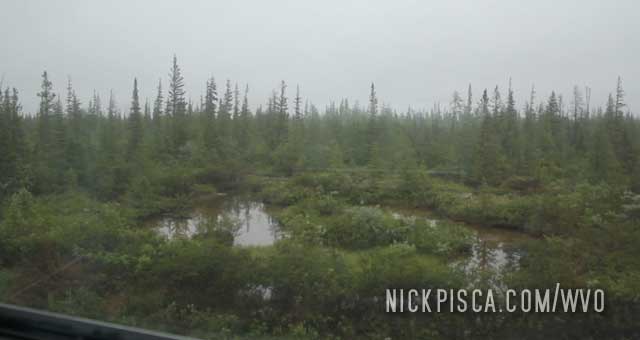
At one point, the train stopped for a minor stop. I looked around. No buildings, no station, just a sign saying the name of this stop. I didn’t see anything for miles. If anyone was getting off here, I’d seriously worry for their safety.
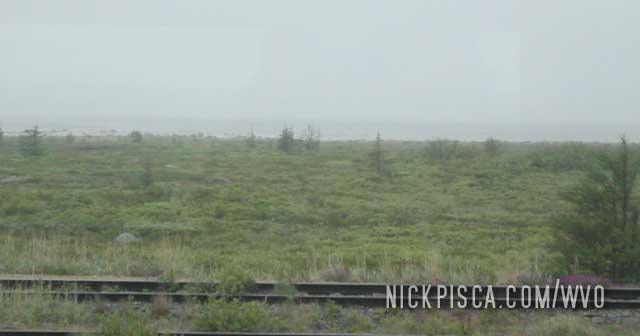
It was getting really cold as we got closer and closer to Hudson Bay. I suspect that if it wasn’t for the bitter July cold, there would be trillions of mosquitoes chasing this slow train as it plodded its way northward.
Gillam is a tiny town in Northern Manitoba. It is the furthest north one can drive in this province. All further transport must be conducted via train or plane.
We took the train from Thompson to Churchill, which involve many minor stops in tiny First Nation towns across the north. A minor stop means the train halts for a moment, and you have to be ready to depart or board immediately. They won’t linger. Gillam is the exception. This time, the train stopped for several minutes, so we took the opportunity to stretch our legs outside in the Canadian North near-darkness.
The station was bustling even though it was passed midnight. There are a lot of mining, forestry, and waterway projects up here, so there was a mix of workers, indigenous, tourists, hunters, and other peoples.
Then the conductor hollered to board and we were on the 10-hour remainder of the journey.
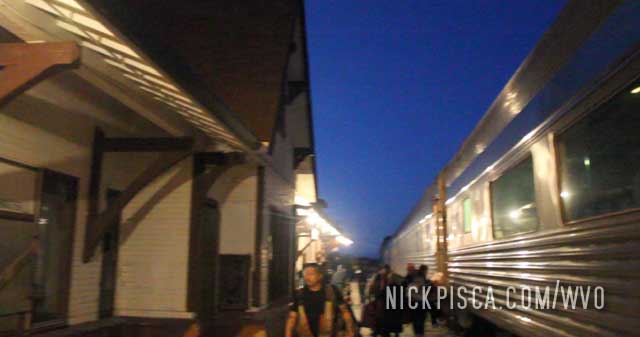
As we watched the Veggie Van disappear on the horizon from the comfort of our train seats, we began to realize this wasn’t just any plain old ride on the light rail in a major city. This was more like what it was like in the old days of the Trans-Continental Railroad in the 1800’s.
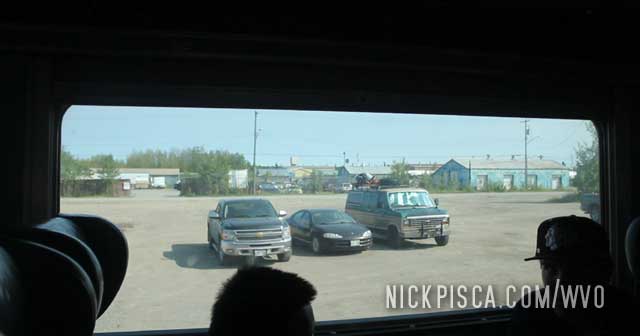
We were tired, and we figured the 18-hour drive would be boring. Little did we know it would be very exotic and different.
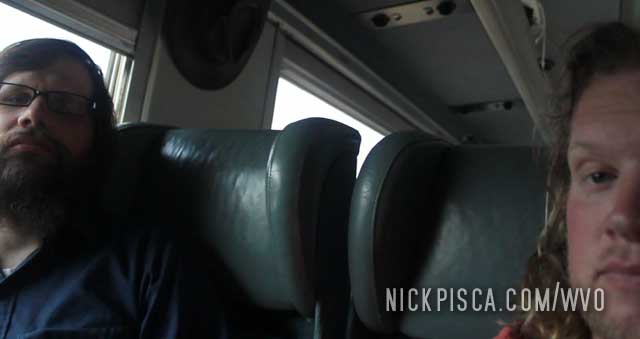
For the first part of the ride, it looked a lot like the typical forests of Canada and northern U.S.
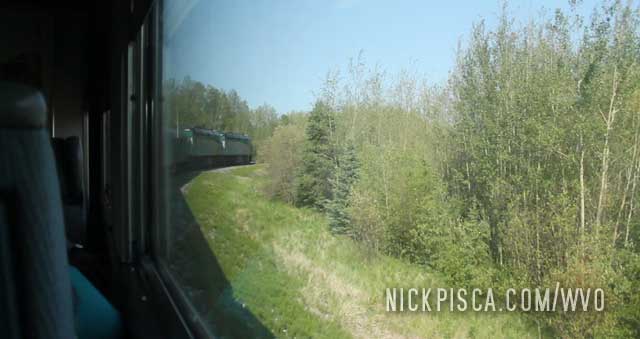
But it completely transformed into vast swathes of tundra. The trees have a hard life here. Since there is very little growing season and little-to-no nutrients in the soil, they grow at an astonishingly slow rate. It looks like something out of a Star Trek movie.
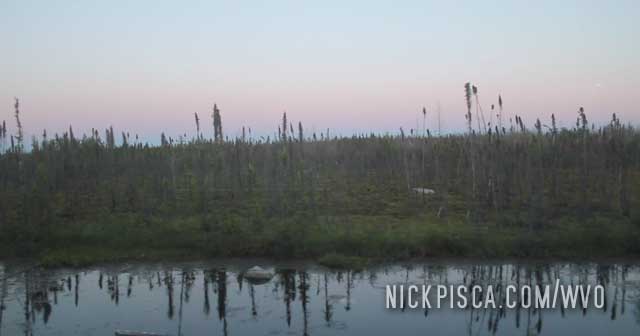
Also, since the train is the only means for First Nations people to travel back and forth to the grid, there are a batch of First Nation hamlets scattered along the path. When you pull up to their respective stations, local people file off and on the train like it’s a subway car. It really does feel like we have warped back to 1875 and we are travelling from St Louis to San Francisco. That’s not an insult; it’s actually a really rewarding experience. It must be very special to live in this type of environment. (It’s a shame that in 2017, the train tracks had a catastrophic failure, and the corporate entity that controls the train system and the Canadian government cannot find an agreement to fix and reinstate this valuable transportation service.)
As mentioned in the previous article, the train to Churchill goes from Winnipeg to the Hudson Bay. The only workaround to the 3-day train ride is to drive up to Thompson or Gillam and hop on the train there. Since we were having both van engine and Canadian weather problems, we elected to buy some tickets in Thompson instead of Gillam and get on the train there.
The Manitoba “highway” #6 is all paved, thank Zeus, but it’s still a long and remote journey. We ended up passing through the Pisew Falls area and pushed on to Thompson right before midnight.
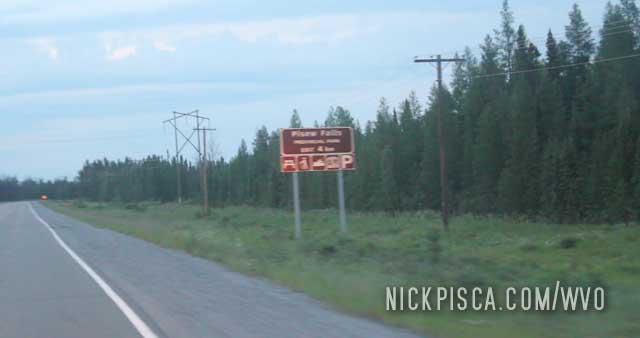
We got a hotel (we needed a nice place because we were smelly, beat up, and thrashed from the long drive and roadside mechanical repairs), and got some much needed rest. The next morning, we ventured off to the train station right when they opened to buy some train tickets. The clerk was exceptionally helpful, and he explained all the nuances about traveling by train in the tundra.
Some things we learned:
First, the train is exceptionally reliable in the winter, but not so reliable in the summer. The frost keeps the tracks parallel and straight in the cold months, but once the soil thaws, it heaves the soil around messing up the tracks. It’s not uncommon for the train to have to say under 20 mph for the 1063-mile trek, which makes it a lot longer than the projected three days on the ticket.
Second, even with the advance of being in Thompson, it is still an 18-hour ride up to Churchill. This part of the train is especially susceptible to frost heaves, so the journey is very slow. Also, once we boarded the train, I was surprised how many railway “turn-arounds” there are by Thompson, Gillam, and Churchill. You think you are close to the destination, but there are several tertiary tracks that force the conductor to meander around to get the overall train into the right directionality and location for the station. It’s not just a hop on the train and straight shot to the destination.
Third, it’s not uncommon for the train to derail, leaving the occupants stranded for days, both on the tracks and in Churchill. There is only one track up to Churchill, so the “rescue” and repair train utilities have to trudge up to the location of the derailment, and meticulously realign and reinstall the train on the tracks. For those stranded in Churchill, there are flights back to civilization, but they are costly.
Fourth, the passenger train is only one small component to the transport system up there. Most of the train activity on the tracks is related to grain and agricultural transport, because the Hudson and James Bays are the main waterway for all Saskatchewan and Manitoba international shipping. Any of these heavily-loaded commercial trains could also derail, further postponing any public transport train activity for days.
The train station clerk took our money for the tickets and told us that the train is expected later that day. So we ventured off to the “metropolis” of Thompson. It’s a rather large town for the area, but relative to the rest of North America, it’s quaint and tiny.
South of town, there is a great museum called the “Heritage North,” which showcases a lot of local artifacts. We spent several hours there in their building and on the grounds.
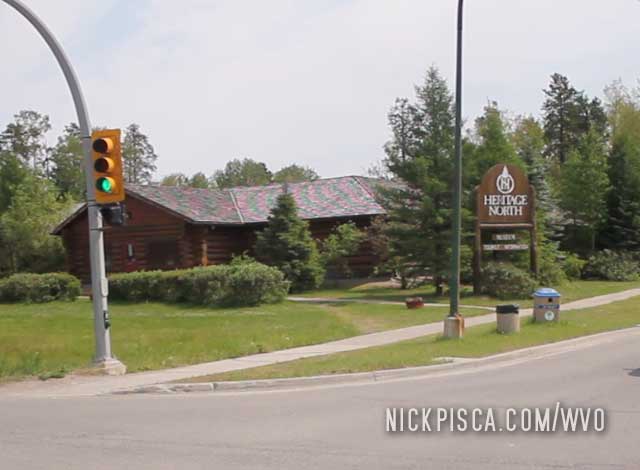
After we ate a quick meal there on their picnic tables, we headed over to the train station. When we were at the station in the morning, it was pretty dead. But now that the train was on the horizon, the place was bustling with travelers and all sorts of commotion. It was pretty cool.

We parked the van next to the other vehicles in long-term parking, and boarded the train. We watched the veggie van disappear in the distance as we ventured off into the great northern wild tundra.
While Glenn and I have never had issues with any First Nation people ever (except one drunk dude that was perturbed about his picture being taken in Lac La Biche), we were constantly inundated with southern white Canadians that were quite critical of their fellow northern neighbors. They would say things like “Thompson is a shithole,” or “I wouldn’t leave your van parked in Thompson,” or “They [the Indians] will steal all your shit.” It was a constant refrain. So we didn’t know what to think. As far as we could tell, the place looked like a nice town with nice people. So when we left the van at the station, we didn’t know if it would still be there when we returned. (Spoiler alert: not only was the van still there unmolested, no “Indians” stole our scooters or supplies on top. Take that, racists.)
As you drive further north, the wilderness transforms into tundra. Gradually, what starts are pockets of swampy bog turn into wide swaths of treeless permafrost. Here was a section of that south of Ponton.
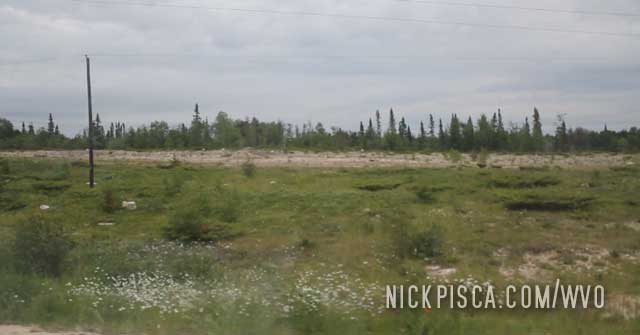
Also, as we got further north, the sky never really got too dark. It was getting quite late in the evening, and this was the view north from our van.
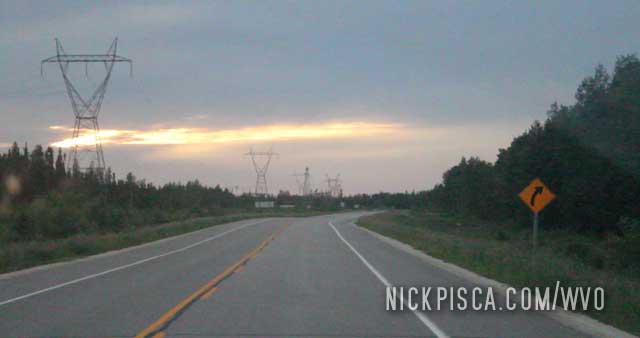
At the junction of “Highways” 6 and 39, there is a general store and gas station called the Ponton Service Station. We stopped in to check it out, but didn’t really need anything. From what I hear in 2019, they have permanently closed now. Bummer. That area really needed some kind of business substructure.
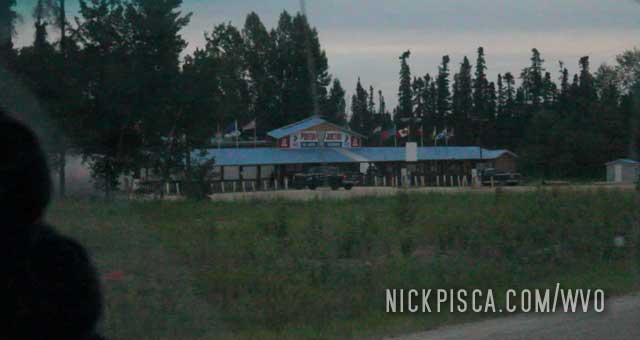
When we did this WVO roadtrip in 2016, there are two ways to Churchill MB: Plane or Train. Now, since the train tracks got washed out in 2017, the train is no longer an option. Even back in 2016, the tracks looked in rather shabby shape, as you can see in the photo above and below. This was located near Warren MB, which is a small town on the trip up to the Churchill.
You might be wondering, why the hell are we driving up to Churchill if there are only two (now one) ways to get to the town, located on the Hudson Bay? Well, we are extraordinarily cheap with money and time. The train travels from Winnipeg to Churchill every three days. It’s a 6 day roundtrip, because it takes 1.5-2 days to travel there and back. Also, it costs something like $500 per person to travel from the Peg to Churchill, so with that kind of impact on our schedule and pocketbook, we elected to do the next best thing: Drive up to Thompson or Gillam in the north of Manitoba and hop on the northbound train.
While this is moderately cheaper (I think it was $300 or so to take the train, crazy expensive), this presented some serious considerations. First off, if we missed our train, we were SOL. If we drove all the way up to Gillam and Thompson, and the train had already stopped on through, we would be left behind. Since the train is notoriously late in the summer (no fault of their own, because the frost heaves contort the tracks, forcing the engineer to slow to a crawl), we figured missing the train wouldn’t be a problem. Second, the stops in Gillam and Thompson are VERY remote, and the station is not always open. While it’s easy to buy tickets online and in Winnipeg, it’s hard to make sure we arrive in Thompson and Gillam at a time where we can buy tickets when the ticket office is open. Thirdly, there is always the risk that the train will be booked up, leaving us high and dry in Gillam and Thompson. The train is the main transportation service for all the First Nation hamlets scattered in the Manitoban tundra, so it is frequented by many northern indigenous people. Also, this is the heart of the Canadian summer, so there are several tourists chomping at the bit to go up to Churchill for a Beluga Whale tour or Polar Bear siteseeing adventure. So things were tight.
Lucky for us, we did manage to get up to Thompson. Unlucky for us, our van had that pesky oil-in-coolant problem, forcing us to cut our drive up to Gillam short. Thompson was our second choice, but after reviewing the road conditions up to Gillam, it was probably a wise choice even with a tip-top van. The roads are mostly mud and gravel, and this particular week had been especially rainy.
Anyway, I took this picture of the railroad, because it just struck my interest. I couldn’t believe that people were taking this rickety old track up to Churchill. Soon, we would be on those rickety tracks ourselves.
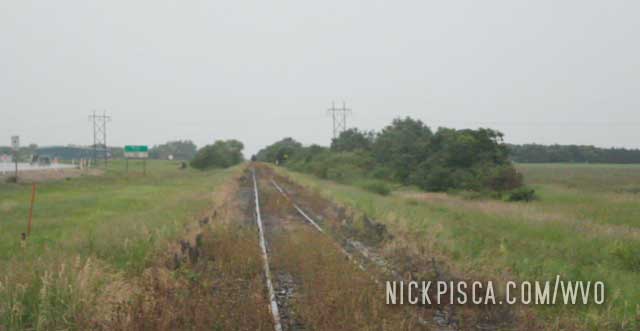
As we trekked northward, we encountered the small First Nation town of Grand Rapids. Nice little place, and it’s cool how different the culture it gets as you drive further and further north.
It was getting increasingly rainy as we progressed on this trip. For a July, it was rather cold and wet. I bet it was probably in the 50’s maximum in the day, and close to freezing at night.
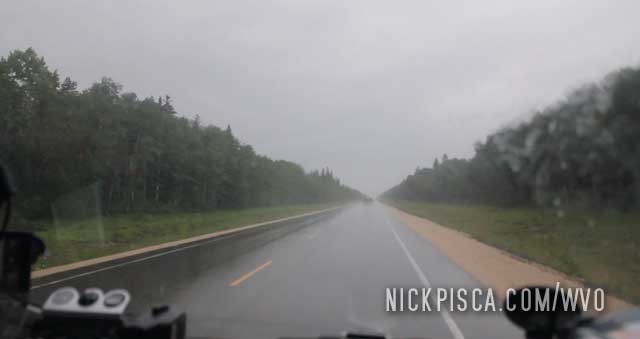
After driving for hours without seeing much, suddenly signs started appearing on the horizon.
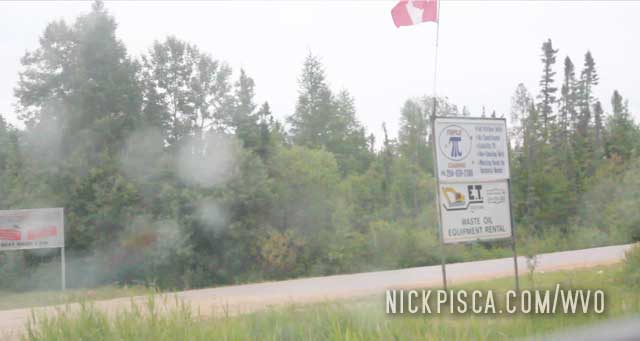
Eventually, we crossed the Saskatchewan River which connects the huge lakes Winnipeg and Cedar. That puts us into the heart of Grand Rapids.
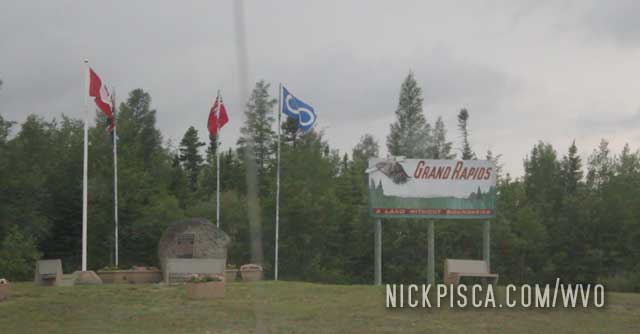
We’ve been all over northern Canada, and one thing I’ve noticed in the northern First Nation culture is their love of free range kids. Kids are always roaming around, playing, investigating, and so on. It’s really cool. I kind of wish more southern towns allowed kids to be kids like this.
Interestingly though, as we drove through Grand Rapids, we found a cadre of kiddos literally climbing the top of their amphitheater! Talk about a wild time!
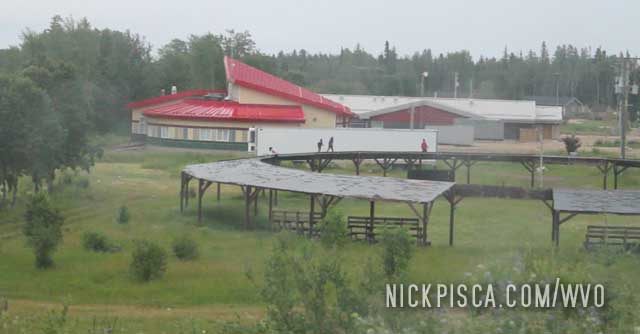
We’ve visited Kenora several times, in 2016, 2015, 2010 and so on.
So, in 2015, we drove to Newfoundland and had a debilitating oil-in-coolant issue unrelated to our veggie oil system. I thought I had fixed the problem in the off-season, by installing new heads and head gaskets, but by the time we reached Kenora, it was apparent we still had the leak.
So we pulled over at an A&W and investigated the issue. Sure enough, the problem was still there, and it only arose once we put down some major miles.
In order to better assess the issue, without opening the radiator when it’s hot, we decided to use some of our wire to make a temporary dipstick, which would reside in the coolant reservoir. Since we were already this far, we figured, we should keep driving the 2016 roadtrip and see if the problem gets worse.
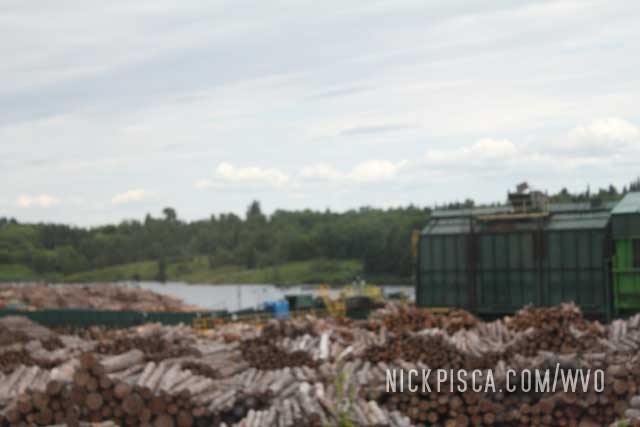
Here’s me building the dipstick:
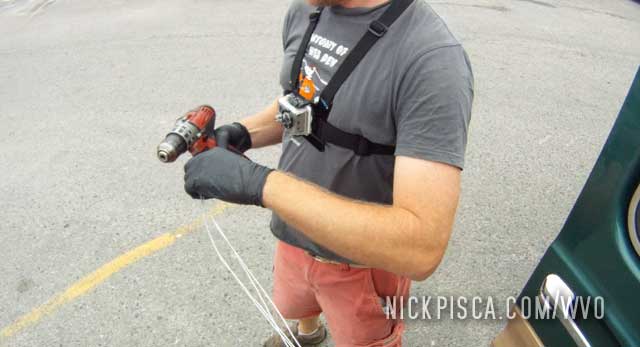
Also, we stopped through Kenora in 2010:
Lots of oddities on the way from the Ontario border to the Peg. The top hat really completes this piece.
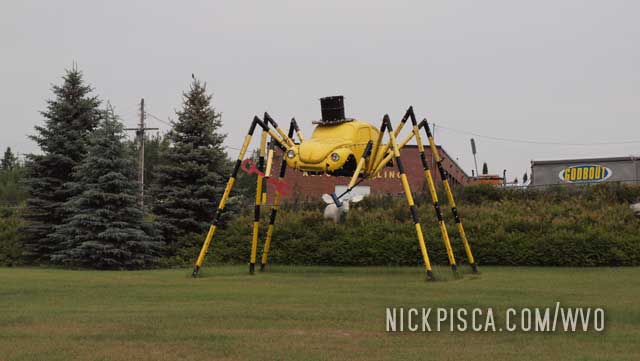
Kokoms restaurant makes some delicious food with a native delicacy called Bannock.
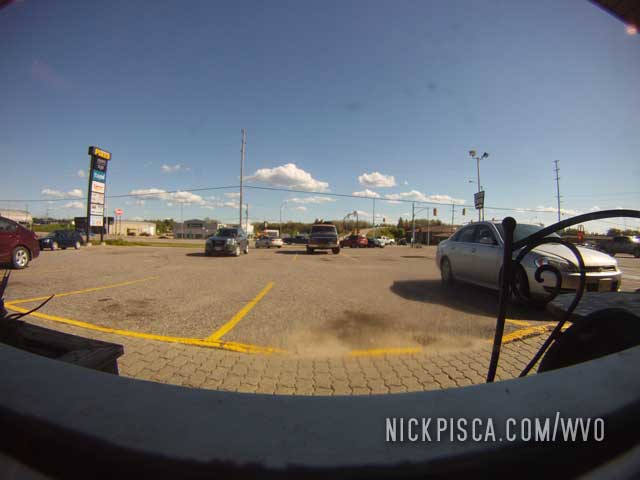
Back in 2010 or 2012 (I can’t remember, getting old), we ate our first bite of Bannock. We were driving through Smithers British Columbia, and there was a food stand on the side of the THC. Never missing an opportunity to eat food, we pulled over. It’s basically a sweet bread, and you pour on honey or corn syrup to give it a little oomph. The closest analog in the American southwest would be sopapillas or in the midwest would be a light and airy biscuit.
When we entered Dryden Ontario, we stopped at their delightful Tourism Center. We always ask, what’s something we can eat here, that is like no where else in the world. They immediately said we should eat a Kokom’s Bannock Shack, where they make burgers and fries with Bannock buns. What a delightful fusion: greasy delicious hamburger smooshed between a couple sweetened bread buns.
Overall, the place was pretty damn good. They even had a vegetarian menu (you have to ask for it), and their veggie-bannock-burger was even better than their actual bannock meat hamburger.
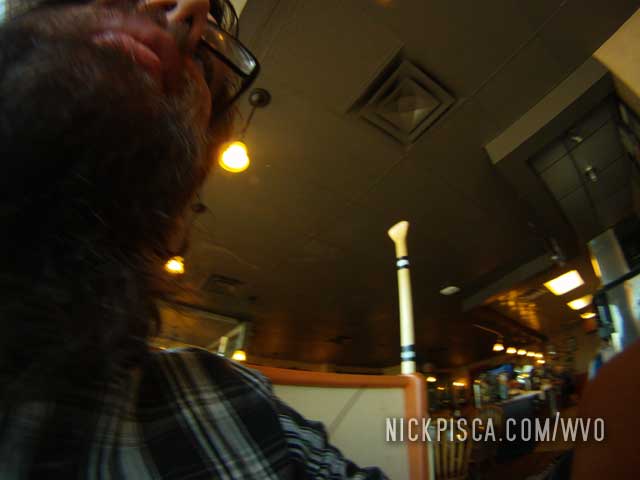
After driving cross country with three kids, we needed a break. The Antique Car Museum of Iowa, in Iowa City, is a great place to stretch the legs. The kids liked all the oddball cars and vehicles. They also had this crazy organ and jukebox from the olden days.
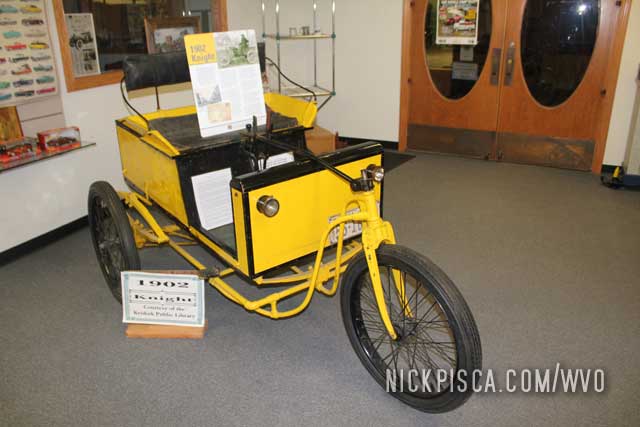
Cool dinosaur museum with animatronic monsters!
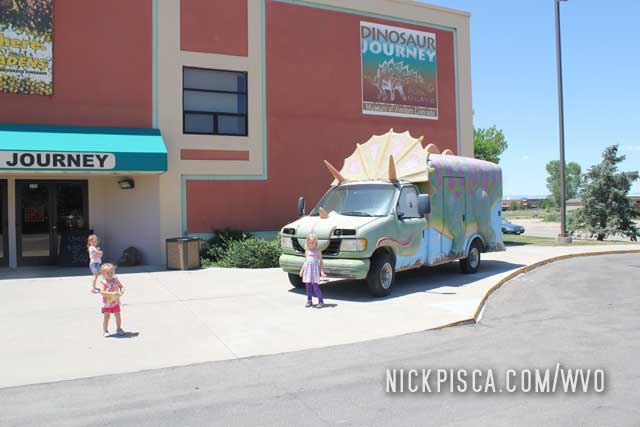
The kids loved it, but one of the little ones skirted the walls avoiding the t-rex.
There is an ongoing massive sculptural project in the Black Hills of South Dakota. It’s the Crazy Horse Monument, and it is staggeringly larger in scale compared to Mount Rushmore. I have been keeping track of this project since 1993, and we have visited it in 2004, 2013, and 2016. We would have visited it in 2015 as well, but it was getting late in the day and we elected to watch the Mount Rushmore night show, which is nearby.
In 2015, we visited the monument in the afternoon. The progress is still slow, but it’s making some headway. Get it? They recently finished the face and they are working on the arms next. The sculpture is situated in the forest, and people are encouraged to visit the site by occupying a rather large complex, housing a museum, cafe, gift shop, and other things. They have musicians playing native instruments, and the museum is entirely focused on native artifacts.
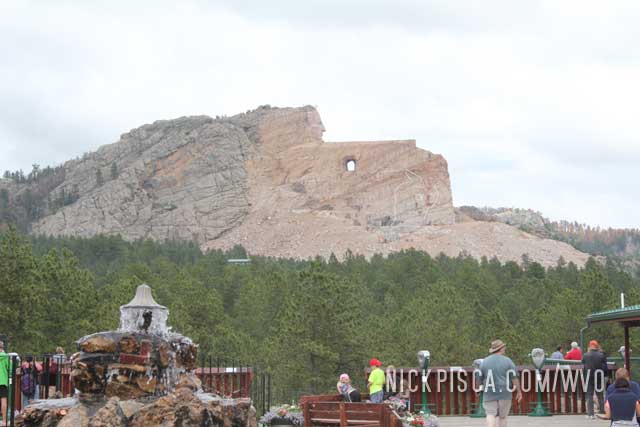
It’s really impressive, much more impressive than Mount Rushmore. But the original designer of the monument was stringently anti-government, and he and his family has rejected all offers to aide him in the process of finishing this work.

2016

2016

2016

2016

2016

2016

2016

2016

2016

2016

2016

2016

2016

2010, 2016

2016

2016

2016

2016

2016

2013, 2016